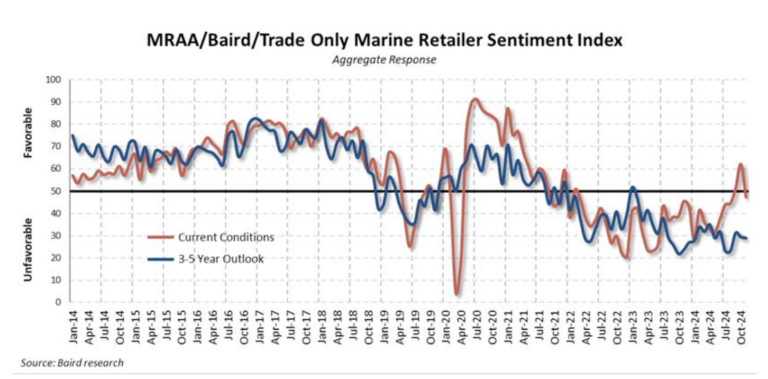
The U.S. economy added a net 12,000 jobs in October after a turbulent period that included two hurricanes and the ongoing strike at Boeing. However, the unemployment rate held steady at 4.1%, and a Wells Fargo executive who follows the recreational marine industry said the unchanged jobless rate was the most notable figure in the latest Labor Department report.
“The key stat in the report is the unemployment rate, which has been stable for the past few months,” Chad Lyon, managing director, global inventory finance, at Wells Fargo, told Soundings Trade Only. “The job numbers announced each month have moved around, creating questions on the underlying strength of the job market. The positive point that the marine industry can take away from this is the steady unemployment rate, with low first-time jobless claims, because it shows a healthy labor market and should be reflecting a good underlying economy.”
Ian Wyatt, director of economics at recreational marine lender Huntington Commercial Bank, told Soundings Trade Only that the jobs numbers will probably rebound in November. “There was a lot of temporary noise in the data,” Wyatt said. “While many focused on the impact of the hurricanes that hit the Southeast, the Boeing strike may have had a bigger impact. Transportation equipment manufacturing, excluding motor vehicles (so likely aircraft), lost 44,000 jobs.
“Next month, with the strike over and the Southeast recovering, we are likely to see a rebound in employment,” he added. “I would put less weight on the employment numbers this month and next month with all of these temporary factors. Beyond the jobs number, other data points looked pretty good. The unemployment rate held steady at 4.1%, and average hourly wages are up 4% year-over-year, while prices are up 2.4% over the same period. Wage growth is easily outpacing inflation, and that is feeding into the strong spending data we saw earlier in the week. While September jobs growth was strong at a now revised 223,000, this report combined with the August report (plus-78,000) suggest that trend is likely about 150,000 per month, which is decent but not great job growth.”
Breaking down the report by sector, Wyatt said job growth was “pretty modest or flat in most categories. Outside of transportation equipment, another big weak spot was professional and business services, which shed 47,000 jobs — this has been a weak sector for the past year. Most people think of accountants and lawyers when we talk about professional and business services, but it also includes temporary help services, and that industry accounts for the losses. The temporary-help industry lost 49,000 jobs over the past month and about 200,000 over the past year. These workers often provide a marginal, flexible labor supply across many industries, including manufacturing and warehouses.”
Wyatt added that softness in durable goods spending likely contributed to the temporary-help employment trend. “Third-quarter spending on durable goods showed a rebound, and hopefully that starts to push through to temporary help and manufacturing employment.”
The job gain in October was the smallest since December 2020. The government not only reported only a weak increase for that month, but it also reduced its numbers for the previous two months by a total of 112,000. August’s figure was revised downward by 81,000, to 78,000, and the September number was lowered by 31,000, to 223,000. Economists’ consensus forecast was that the economy would add about 100,000 jobs in October, but the predictions had ranged widely, and some had, in fact, suggested just a 10,000-job advance.
The Federal Reserve’s policymaking committee was to meet Nov. 6 and 7, just after the presidential election, to decide whether to further reduce interest rates. The Fed is expected to approve a cut of 0.25% in the federal funds rate, its benchmark rate, following a 0.5% reduction in September.
“There is a lot to unpack as you assess the economy and the Fed’s direction on interest rates,” Lyon said. “One of the driving key points, as you assess various scenarios, has been the Fed signaling toward bringing real rates down — keeping in mind, the large gap between the fed funds rates and inflation is restrictive policy. Judging by recent behavior, it seems like the Fed will focus on the lower headline job numbers reported (and the downward revisions to prior months) along with stable unemployment rates, lower job openings and generally falling inflation numbers to continue the loosening cycle on rates.”
Wyatt said he expects the Fed to approve a 0.25% rate cut. “The big question is, will there be another cut at the December meeting?” he said. “Right now, another 25 basis points in December is our base case, but stronger economic data, which several Fed governors have noted in their recent comments, make the case for a December cut a bit weaker, and the board was already closely divided. Doubts about the pace of future short-term cuts and concerns about government budgets have driven up longer-dated rates. Most longer rates are up substantially since the Fed cut short-term rates. The pace of the upward move in long rates following the first cut to the fed funds rate is surprising.
“Unfortunately, this rise in Treasury rates across the forward curve (1-year to 30-year Treasuries) does create a real headwind for marine sales because boat financing costs are closely tied to longer Treasury rates,” he added.
“The good news for the boating industry is that spending on durable goods (like boats) rose at an 8.1% annual rate in the third quarter,” Wyatt said. “October auto sales are expected to hold steady at a 15.8 million annual rate (Cox). Consumer incomes are rising, jobs are still growing, and the stock market is still up about 20% this year (S&P 500). Consumers, who have been putting off purchases of durable goods, are showing signs that they are tired of waiting for rates to fall and are just accepting the current rate environment.”
The government said health care was the job category leader in October, as the booming sector added 52,000 jobs. Employment in government rose by 40,000, and the construction industry added 8,000 jobs. Conversely, employment in temporary help services (within the professional and business services category) fell by 49,000 in October, and manufacturing employment fell by 46,000, reflecting the ongoing strike at Boeing and a four-week strike at Textron Aviation that ended Oct. 20 when the machinists union ratified a new five-year contract.
The government said employment in October showed little or no change in other major industries. The labor force participation rate — the measure of the population that is in the workforce — was 62.6%, down only slightly from 62.7% the previous three months.
The Commerce Department said two days before the jobs report that the economy continued to rise at a robust pace in the third quarter, with inflation-adjusted gross domestic product rising 2.8% after 3% growth in the previous quarter.
The jobs report for October did have good news for workers’ pay, as average hourly earnings rose by 13 cents, or 0.4%, to $35.46, matching the percentage rate of the increases for the previous two months. During the past 12 months, earnings have increased 4%, remaining well above the current rate of inflation. That level of pay hikes continues to support solid growth in consumer spending, which rose in September by an inflation-adjusted 0.4% after climbing 3.7% in the third quarter. Personal income was up by an even higher, 0.5% in September, without adjusting for inflation.
The nation’s consumer confidence surveys both showed rising public optimism in October, with The Conference Board’s Consumer Confidence Index adding 9 points — its biggest one-month gain in three-and-a-half years. The University of Michigan’s Consumer Sentiment Index had a more modest advance.
Meanwhile, data released the day before the jobs report revealed that inflation continues to ease. The Commerce Department said the Personal Consumption Expenditures Price Index, the Federal Reserve’s preferred inflation gauge, rose just 0.2% in September after a 0.1% rise in August.
For the year through September, the index rose just 2.1%, just a tick above the 2% level that the Fed has been striving for the economy to reach. It was the smallest year-over-year increase since February 2021. The so-called core PCE index, which excludes the volatile food and energy sectors, rose 0.3% in September after a 0.2% gain in August; the core index rose 2.7% on a year-over-year basis. The monthly increase was the highest since April of this year.
Wells Fargo’s Lyon says current trends in the economy bode well for the boating industry. “The marine industry has felt the benefits of falling interest rate expectations resulting in lower retail rates, as we have seen at this year’s fall shows, which hopefully is leading to increasing consumer demand,” Lyon said. “The recent change in consumer confidence should also create tailwinds for consumers interest in recreational boats. Overall, the data does create an economic picture that should be helpful for boat sales, with low unemployment, a good stock market, falling interest rates and lower inflation.”
Ahead of the jobs report, the Labor Department said in its monthly Job Openings and Labor Turnover Survey that vacancies nationally fell in September by 418,000, to 7.44 million, from a downwardly revised 7.86 million the previous month. The September figure was the lowest level since January 2021. Hires rose by 123,000, to 5.6 million. Layoffs rose by 165,000, to 1.8 million. The number of job openings per unemployed worker was 1.1, unchanged from the previous two months and about half of the top ratio of more than 2-to-1 in the early months of 2022.
The ADP Research Institute said in its National Employment Report for October that private-sector employment rose by 233,000 jobs — the fastest pace in more than a year — and annual pay was up 4.6% year-over-year. “Even amid hurricane recovery, job growth was strong in October,” Nela Richardson, the institute’s chief economist, stated in a press release. “As we round out the year, hiring in the U.S. is proving to be robust and broadly resilient.”











